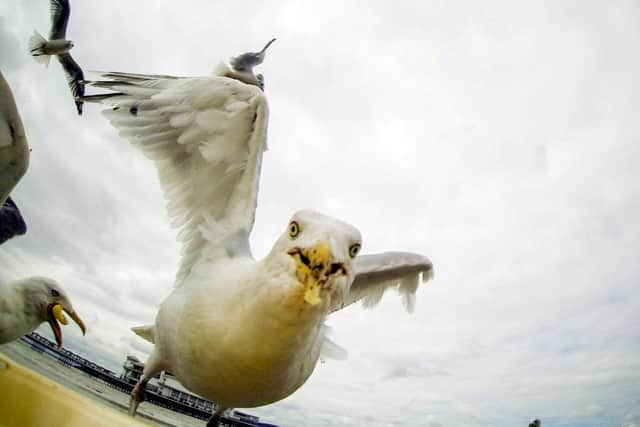The reason seagulls steal your chips and ice cream has been revealed


The reason seagulls will steal your chips has been uncovered, as they actually prefer food that has been handled by humans, new research shows.
The birds swoop on ice creams, chips and other seaside treats because they see people with them.
Advertisement
Hide AdAdvertisement
Hide AdThey see it as a sign of food availability, reacting in a similar way to pet dogs and cats when owners put meals out.


The findings shed fresh light on the increasing number of attacks by the dive-bombing birds.
In the study, herring gulls were presented with two identical food items - one of which they had seen a person holding.
They pecked more often at the handled food, suggesting they use human actions when deciding what to eat.
Advertisement
Hide AdAdvertisement
Hide AdThe scavenging birds are notorious for stealing chips and snatching ice cream out of unsuspecting tourists' hands.


The finding follows research by the same team last year that found staring at seagulls makes them less likely to steal food.
Lead author Madeleine Goumas, a zoology Msc student of the Centre for Ecology and Conservation at the University of Exeter's Penryn Campus in Cornwall, explained: "I presented individual gulls with two identical food objects, and only handled one of them.
"When I moved away I could see which item, if any, the gull approached. We found the majority of gulls pecked at the item I had handled.
Advertisement
Hide AdAdvertisement
Hide Ad"This implies they are using human cues when making foraging decisions in urban areas."
Ms Goumas said the study published in the Royal Society journal Open Science offers hope of thwarting the growing problem.
She said: "We could potentially do things to change our behaviour to stop this association being used and prevent gulls from eating the food we are dropping."
The unique experiment was carried out in Cornish towns including Falmouth and Penzance.
Advertisement
Hide AdAdvertisement
Hide AdMs Goumas approached individual gulls and placed two buckets on the ground in front of them, each covering a wrapped flapjack.
The buckets were then removed, and she picked up one of the flapjacks, handled it for 20 seconds, and then put it back down on the ground.
In total, 38 gulls were tested with 24 pecking at one of the flapjacks. In 19 of these cases (79%), they chose the one that had been handled.
Ms Goumas said: "UK herring gull numbers are declining, but urban populations have increased.
Advertisement
Hide AdAdvertisement
Hide Ad"Despite the fact they are a common sight in many towns, little is known about urban gull behaviour.
"We wanted to find out if gulls are simply attracted by the sight of food, or if people's actions can draw gulls' attention towards an item.
"Our study shows that cues from humans may play an important part in the way gulls find food, and could partly explain why gulls have been successful in colonising urban areas."
To see if gulls were responding to human handling alone, the test was repeated with two non-food items - sponges that were cut into the same size and shape as the flapjacks.
Advertisement
Hide AdAdvertisement
Hide AdBut their preference for the handled sponge did not exceed "chance levels", suggesting it is handling that draws their attention to food in particular.
Added senior author Dr Laura Kelley: "Our findings suggest gulls are more likely to approach food they have seen people drop or put down, so they may associate areas where people are eating with an easy meal.
"This highlights the importance of disposing of food waste properly, as inadvertently feeding gulls reinforces these associations.
"Herring gulls have a generalist diet that typically includes fish and invertebrates, but they will also consume food found in landfill sites and household waste.
Advertisement
Hide AdAdvertisement
Hide Ad"The effect of this shift in food quality and quantity away from more 'natural' sources is not yet clear.
"Herring gulls are quite adaptable and are likely to be moving into urban areas because of the resources available.
"For example, there are lots of suitable nesting sites, and a ready supply of food.
"Urban environments may also be able to support larger gull populations, meaning that competition among individuals for resources is lower than in rural coastal colonies."
Advertisement
Hide AdAdvertisement
Hide AdHerring gulls are the most common of Britain's seagulls, but between 1969 and 2015 the population fell by 60 per cent, with plastic pollution blamed.
Added Ms Goumas: "It is well-known domesticated animals such as dogs use human cues to infer the location of food. We found wild animals use human cues too.
"With urbanisation increasing and food litter being commonplace, wild animals may learn to associate human behaviour with food availability.
"Herring gulls are Britain's best-known 'seagulls.' They also use human cues when searching for food.
Advertisement
Hide AdAdvertisement
Hide Ad"These findings show that subtle human behaviours can unintentionally direct gulls towards food."
In August her team reported the birds were put off from approaching food when a human looked them straight in the eye.
They put a bag of chips down on the ground as bait - and recorded the birds' 'waiting time'.
Only just over a third - 27 out of 74 - went for the snack. And it took them 21 seconds longer, on average, than when the person looked away.